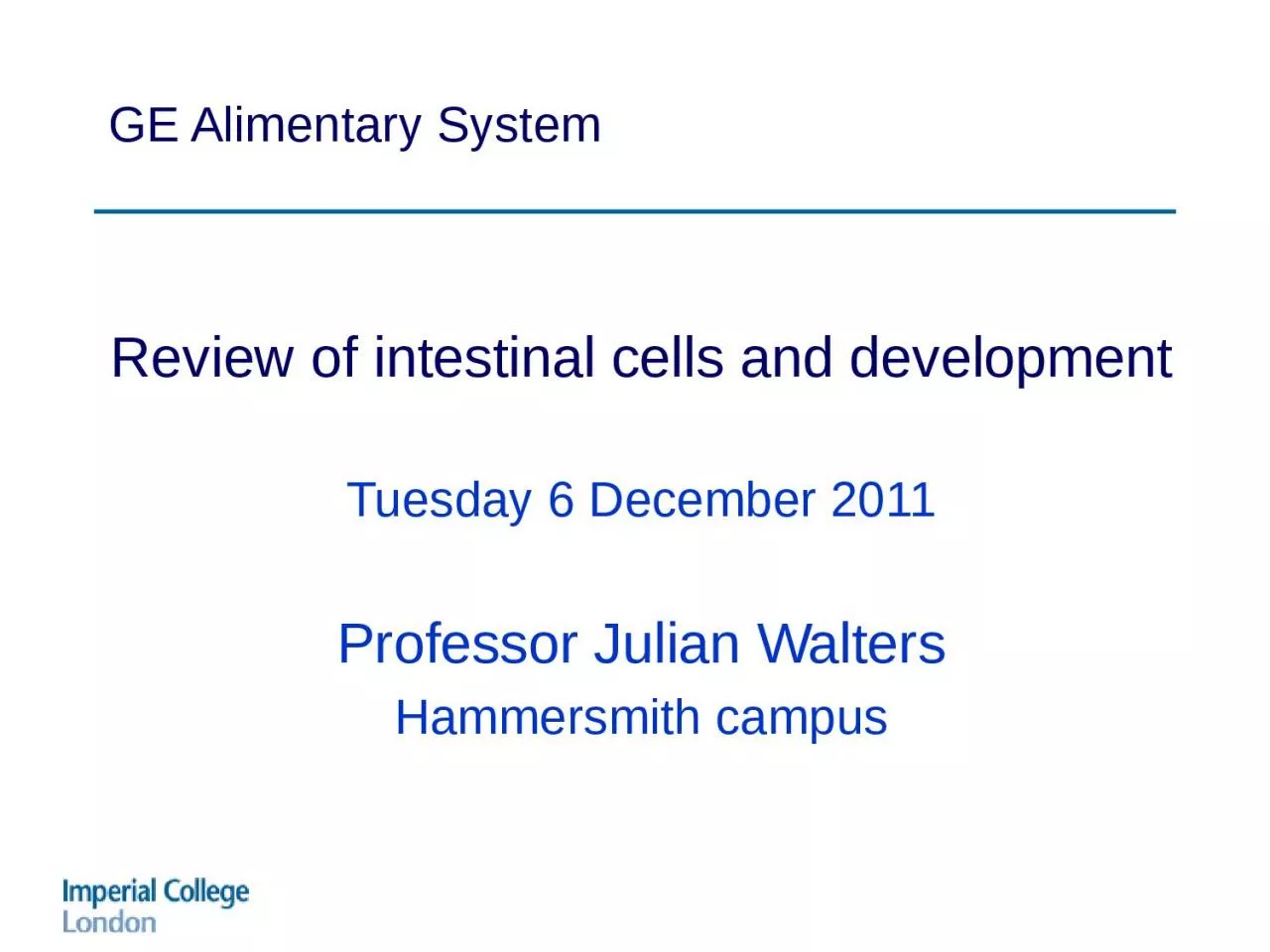

Tuesday 6 December 2011 Professor Julian Walters Hammersmith campus Intestinal cells To review the structure of the small and large intestine To review the types of cells found in the intestinal mucosa ID: 1047621
Download Presentation The PPT/PDF document "GE Alimentary System Review of intestin..." is the property of its rightful owner. Permission is granted to download and print the materials on this web site for personal, non-commercial use only, and to display it on your personal computer provided you do not modify the materials and that you retain all copyright notices contained in the materials. By downloading content from our website, you accept the terms of this agreement.
1. GE Alimentary SystemReview of intestinal cells and developmentTuesday 6 December 2011Professor Julian WaltersHammersmith campus
2. Intestinal cellsTo review the structure of the small and large intestineTo review the types of cells found in the intestinal mucosaTo appreciate mechanisms of cell turnover and differentiation
3. Duodenum, Jejunum and IleumMain Functions: Digestion, absorption, motilityDuodenum 25cmJejunum ~2.5mIleum ~3.75m Fan-shaped mesentery throws intestine into folds and supports the blood supply.
4. Endoscopic appearances of duodenumFolds of Kerckring
5. Wireless Capsule EnteroscopySince 2001Disposable capsule2 frames per second8 hour battery lifeRecording system worn externallyImages analysed at a later time
6.
7. THE INTESTINAL MUCOSAVillusCryptMuscularis mucosaSubmucosa
8. Tissue Organisation of Small Intestine
9. THE INTESTINAL MUCOSAAmplification of surface area by villi
10. THE INTESTINAL MUCOSAFurther increase in surface area for absorption by microvilli (brush-border membrane) of enterocytes
11. INTESTINAL SURFACE AREAType of SurfaceAmplification FactorSurface Area (cm2)Mucosal cylinder13,300Folds of Kerckring310,000Villi10100,000Microvilli202,000,000Total surface area = 200 m2Double tennis court = 175 m2
12. EM of IntestineNote:MicrovilliER in absorptive cellsGoblet cell with mucus vesiclesNucleusCapillary with erythrocyte
13. INTESTINAL STRUCTUREVillus tip enterocytes express the genes that are necessary for active transport
14. Digestive and transport properties of villus and crypt regions differBrush border hydrolasesNutrient transportNet water & ion transportPermeabilityVillusAbundantHighAbsorptionLowCryptSparseLowSecretionHigh
15. Cells of the Intestinal MucosaEnterocytes Goblet cells M-cells Enteroendocrine cellsPaneth cellsIntra-epithelial lymphocytes (T)Lamina propria lymphocytes (B)Dendritic cellsMonocytes MyofibroblastsVascular & lymphatic cellsNeuronal cells etc.Stem cells
16. Base of Small Intestinal CryptStem cell in mitosisPaneth cell
17. Epithelial Cells Are Continually RenewedCell death (apoptosis) and extrusion Turnover time = 48 – 72 hDividing cellsStem cells Number of cells lost = number of cells formed
18. The Brush-border & Basolateral domains of enterocytes are structurally & functionally distinctGlycocalyxComplex cytoskeletonSpecific exchangers & channelsSimple cytoskeletonDifferent exchangers & ion-pumpsApical brush-border membraneBasolateral membrane
19.
20.
21. Types of Transport in the Intestine
22. Secondary Active Transport – CotransportOutInNa+ / glucose cotransporter (SGLT1)Na+GlucoseCo-transport = Na+ (or H+) -linked, (coupled) transportUses existing gradientsNa+ / amino-acid cotransporter(+ many others)Na+AAH+ / amino-acid cotransporterH+AACa2+Na+K+
23. Gene Expression in the IntestineDifferences inCrypt and villusRegions of intestineDuodenum / jejunum / ileum
24. Rates of Absorption of Different Nutrients Along the Small IntestineDuodenumJejunumIleumCarbohydratesProtein & LipidsIron & calciumBile saltsCobalamin (B12)
25. Expression Profiling using cDNA MicroarraysDavid J Duggan et al. Nature Genetics 21, 10 – 14 (1999)
26. Microarray Study of Mice Gastrointestinal Genes Numbers of genes highly expressed in specific segments of the adult mouse GI tract. Bates et al. Gastroenterology 2002
27. Microarray Study of Mice Intestinal Genes Expressed in Crypt and Villous Cells14,685 unique genes 1113 differentially expressed genesChanges demonstrated in genes for: cell-cycle RNA processing cytoskeleton Transport Wnt pathway (Myc , MAD , MAX etc.)Gene expression profiling of intestinal epithelial cell maturation along the crypt-villus axis Mariadason et al. Gastroenterology 2005
28. Colonic structure
29. Large intestine epithelium
30. Colonic cells
31. Colon histologyNo villiDeep CryptsMany goblet cells
32. Regulation of Intestinal Cell GrowthChanges with dietDevelopmentWeaningRepair after injuryIschaemiaInflammationRadiationChemotherapyAdaptation following surgery
33. Regulation of Intestinal Cell GrowthEndocrine factorsEpidermal Growth Factor (EGF)Glucagon-like peptide 2 (GLP2)etc.Paracrine factorsWnt pathwayHedgehog pathwayBMP pathwayetc.
34. WntReya & Clevers. Wnt signalling in stem cells and cancer. Nature 2005; 434, 843-850Canonical Wnt signalling pathway
35. APC, -Catenin, Wnt, SOX9, CDX1, CDX2APC targets -Catenin for degradation-Catenin/TCF functions as transcription factorLoss of APC increases Wnt pathway activityIncreased Wnt pathway activity in colorectal and other GI cancerSOX9 important intestinal crypt transcription factorCDX1 & CDX2Regulate many genes expressed in intestine
36. Wnt & Colorectal CancerReya & Clevers. Wnt signalling in stem cells and cancer. Nature 2005; 434, 843-850Activation of Wnt cascade in CRC(mutations in APC or other genes in pathway)Excess unregulated proliferation
37. Hedgehog(Shh, Ihh)Patched receptorCyclopamineSmo GliMany genesHedgehog targets
38. Hedgehog pathwayActivation of Hedgehog pathway in many tumoursDigestive tract (increased SHH / IHH expression)oesophagealstomachpancreaticbiliary (not colonic)Berman et al. Nature 2003Thayer et al. Nature 2003Interaction of the Hedgehog, Wnt and BMP4 systems IHH in differentiated colonocytesdownregulation of Tcf4 & -cateninVan der Brink et al. Nat Genet 2004
39. Bone morphogenetic proteins(BMP2, BMP4)NogginBMPRIa / BMPRIb + BMPRIIPTENSmad(1,4,5,8)PI3KAkt-cateninMany genes Bone morphogenetic proteins
40. Bone Morphogenetic ProteinsPart of TGF- familyBMP2 in colonocytesBMP receptors act via Smad4 and PTENMutations in BMPR1A, Smad4 and PTEN found in juvenile intestinal polyposis syndromes (not FAP or Peutz-Jegher's syndrome)BMPs control duplication of stem cells (prevent crypt fission)Wnt required for stem cell activation and self-renewalHe et al. Nat Genet 2004
41. SummaryThe structure of the small and large intestineThe types of cells found in the intestinal mucosaStructure and functional correlationRegional and crypt differencesAn appreciation of the mechanisms of cell turnover and differentiation